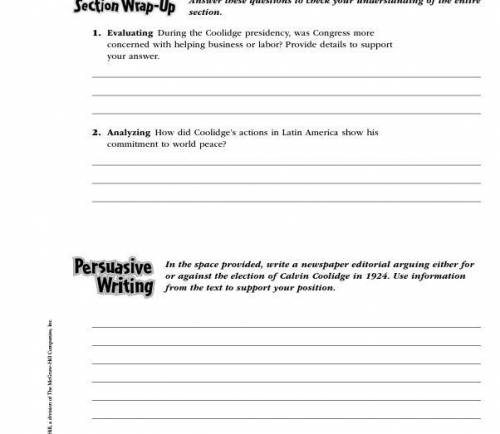
Chapter 10, Section 2 (Pages 308-311)
Desire for Normalcy
Read the passage below then do the worksheet.
Warren G. Harding and Calvin Coolidge were the Republican candidates for president and vice president in 1920. They promised a return to “normalcy” and won the election eas-ily. After the election, Harding appointed several skilled people to his cabinet. However, he also gave some government jobs to political supporters who were not qualified. Some of these offi-cials were dishonest. The biggest scandal during the Harding presidency involved Albert Fall, the secretary of the interior. He secretly leased, or rented, oil reserves owned by the government to two oil compa-nies. In exchange, he was paid more than $400,000. Fall was convicted of bribery and went to prison. Because one of the oil reserves was in Teapot Dome, Wyoming, the scandal became known as Teapot Dome. Harding died in 1923, and Calvin Coolidge was sworn in as president. Coolidge was known for his honesty. After he took office, Coolidge allowed the investigations into the Harding scandals to continue. Coolidge also replaced est officials with honest ones. Harding and Coolidge had similar beliefs about how the gov-ernment should be run. Both thought that government should not interfere in the life of the nation. This is known as a laissez-faire approach to government. During the Coolidge presidency, Congress passed laws to sup-port business. It lowered tax rates for corporations and wealthy Americans. It raised tariffs on imported goods to protect American businesses. Laws that regulated child labor and women’s wages were overturned. Coolidge’s policies were popular. He won the 4 presidential election with 54 percent of the popular vote. Harding and Coolidge believed that the United States should be involved in world affairs as little as possible. This policy is called isolationism. The policy of isolationism kept the United States out of the League of Nations. However, Harding and Coolidge still worked for world peace. In 1922 the United States joined Japan, Britain, France, and Italy in signing the Five-Power Treaty. This treaty limited the size of these nations’ navies. In 1928 the United States was one of 15 nations that signed the Kellogg-Briand Pact. This pact called for outlawing war. Coolidge also reduced the number of U. S. troops in Latin America. American troops had been stationed in the Dominican Republic and Nicaragua since the early 1900s to protect American business interests there. After elections were held in these two countries in the 1920s, the United States withdrew its troops. Coolidge decided not to send troops to Mexico when the Mexican government threatened to take over foreign-owned oil and mining companies. Instead, Coolidge chose to negotiate.


Answers: 3


Other questions on the subject: History


History, 22.06.2019 01:30, nothingworksoutforme
Describe the indian removal from north georgia. was the evacuation carried out according to plan? explain.
Answers: 1

History, 22.06.2019 03:30, kaffolter25
Which type of constitutional power allows congress to regulate immigration and naturalization?
Answers: 2
You know the right answer?
Chapter 10, Section 2 (Pages 308-311)
Desire for Normalcy
Read the passage below then do the...
Read the passage below then do the...
Questions in other subjects:





Social Studies, 13.03.2020 18:02

World Languages, 13.03.2020 18:02






